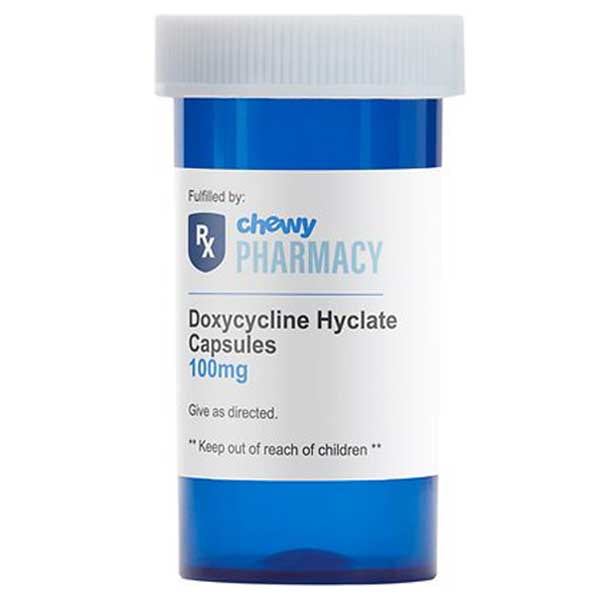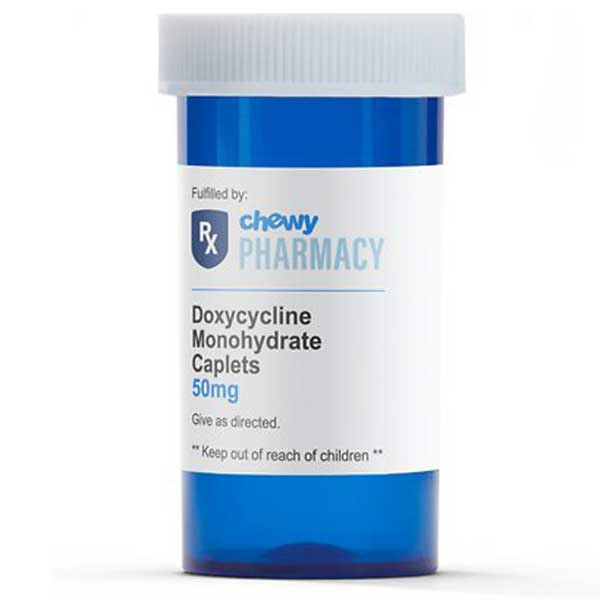Doxycycline is an antibiotic used to treat various bacterial illnesses in dogs. This medicine is what is called a broad-spectrum antibiotic, meaning it can be used to fight various bacteria rather than just one specific one. It has a broad scope of application in contrast to a narrow one. Doxycycline is also a drug that has antimicrobial properties that will target dangerous microorganisms such as Wolbachia, Dirofilaria immitis, E. coli, Pseudomonas aeruginosa, Serratia, Klebsiella, Truperella and more. This makes is an oft used veterinary medicine due to its wide-ranging applications.
There is a family of drugs called tetracycline that is familiar to us as humans. It is a medication that our doctor will prescribe for us for various illnesses that we come down with. Doxycycline is part of this tetracycline family and works against bacterial illnesses as the family of drugs would in us. This particular line up of medication fights off bacteria and microorganisms that cause infections by attaching to ribosomes in the cells of infecting bacteria. This attachment hinders protein synthesis, stopping the growth and division of the bacteria. It also changes the cytoplasmic membrane of those cells that can lead to sickness. The membrane can be permeated by bacteria and infectious organisms, but the tetracycline family makes the membrane less permeable, so infections have less of a chance of getting in. None of this happens quickly so doxycycline is a long term prescription.

Doxycycline is what is called a partially synthetic medication. It comes from both natural and manmade sources which then creates a broad-based antibiotic with significant strength to take on the tough infections. This particular medication is prescribed for your dog by veterinarians who are combating many illnesses such as Lyme disease which is carried by ticks, Rocky Mountain spotted fever, ehrlichiosis, E. coli, UTI (urinary tract infections) and chlamydia. This is just a sample of what doxycycline can be used to treat.
If you have taken your dog to the vet to be checked, your pups’ doctor may find that they need doxycycline to fight off a particular bacterial illness. Should this be the case, you must follow the dosage guidelines given by the vet. Your dog has to have the correct amount of medication for the appropriate length of time. If this does not happen, the medication may not fully address the bacterial issue your dog is suffering with. You will also have to watch for side effects once your dog starts taking the meds. If there are problems, their vet should be made aware so they can be dealt with or their medication changed as needed.
Uses of Doxycycline in Dogs
Doxycycline is an antibiotic that has a great range of treatment possibilities when given to canines. It can fight off many kinds of bacteria in your pup. However, it is limited in its use to fight off viral or fungal infections. Doxycycline may also be used in conjunction with other drugs as a preventative medication. An example of this is when a dog contracts parvovirus. Not only will the vet treat parvo, but they will also use doxycycline in a preventative way to stave off secondary infections so your dog is not fighting on two health fronts. While you are treating one infection, it can be used to protect against a secondary bacterial infection that might happen thus lowering a dog’s immunity even more.
Doxycycline can be used to treat:

Most veterinarians prescribe 2-5mg of doxycycline per pound that your dog weighs. This amount is to be administered either once or twice per day depending on the illness that they are being treated for. The dose can be varied as can the time given once your dog's illness is assessed. Each dog will be different depending on the size and illness.
Doxycycline is not usually a short term prescription. Your dog will have to take it until their vet says they can stop. Sometimes illnesses trick you into thinking your pup is better but in reality, they need longer treatment to get rid of any dormant bacteria to stop a secondary flair up.
Many medications should be taken with food to avoid further discomfort in your dog. While this is not required with doxycycline as is easily taken into your dogs’ system (it has a high bioavailability), it may help to reduce the side effect of nausea. Food helps settle the stomach while aiding in the absorption of the drug. Along with food, fresh water is critical for your dog while they are taking these meds. It helps with hydration, side effects, and absorption of the med.
Your dog’s veterinarian will probably suggest that you give your pup their medication at the same time each day. This is important not only as a reminder to do it but will help keep a stable amount in their system at all times. There will be no medication highs and lows if you do it this way
Doxycycline is available with a prescription. While a vet may prescribe it to the following dogs, it's not always advisable. However, sometimes the vet will feel that the benefits of the medicine will outweigh the risks of taking it.
Doxycycline addresses various bacterial infections in your dog and can be given in various forms as needed. Doses can be given by 100mg tablet, 100mg capsules, 50mg capsule or through intravenous.
If you give them capsules nor non-chewable tablets, you can hide them in your dog's food or in a pill pocket. All these forms of doxycycline work as they have the same medicinal qualities, so choosing how to administer it to your dog is simply personal preference other than the IV as that will have to be done by your dogs’ veterinarian.

All prescription medications for your dog will come with a warning of side effects. Just because they are listed, it does not mean that your dog will have any of them. They may have some or none depending on their systems. The reason these side effects are listed is for precautionary purposes. It's simply to let owners know that there is a possibility of some issues and they should watch for them to make sure their dog isn’t affected by them. Side effects are often rare but better to be prepared in case of one of those rare instances that they are affected.
Some of the named side effects are:
Some of these side effects can be reduced if your pup is given the medication with food. This will help settle their stomachs if they are upset. Water will also help this along with swallowing problems as this is often the pill getting stuck. If nausea and upset stomach get really bad, then there could be a problem with the prescribed amount of medication or a misdosing causing too much to be in your dogs’ system and they start to overdose. Your vet needs to be called immediately if this is the case.
Sadly, Doxycycline can be the reason for limb deformities in puppies while still in the womb. This can also be a significant risk for mom dogs. The drug is not safe for unborn pups but sometimes the vet will feel there is little choice and have to prescribe it for the mom. The hope will be that it will not harm the fetus while healing the mom.
Doxycycline can also interact badly with other medications, so it's important that your dog's vet knows what other drugs it is taking to protect them from potential negative interactions. Some that can cause issues are:

These drugs do not prevent your dog from taking doxycycline but it can mean there will be some adjustments in administration. Some drugs simply can’t be taken at the same time so that means taking doxycycline a few hours before or after them. If it's iron that your pup is taking its needs at least 3 hours. The tetracycline family of drugs can alter the clotting time of your pups’ blood, so if your dog is on a blood thinner your vet will want to keep a close eye on them to make sure the dose is ok and there is no threat to their health.
Product Image | Product Name | Buy Now |
|---|---|---|
Doxycycline Hyclate (Generic) Capsules | ||
Doxycycline Hyclate (Generic) Tablets, 100-mg, 1 tablet | ||
Doxycycline Monohydrate (Generic) | ||
Greenies Pill Pockets Canine Real Peanut Butter Flavor Dog Treats |
Finally, doxycycline can lead to a very serious allergic reaction called anaphylaxis. This means that their immune system goes into severe overdrive in response to the drug being in the dog’s system and creates issues that can be fatal. The dog’s tongue and lips can swell up, they can get extreme hives, or their trachea can swell and stop their breathing. If this side effect happens, your dog needs immediate attention as you will only have a very small window of opportunity to treat them.
While this list of side effects sounds horrible, the chances of them happening are actually fairly rare. Doxycycline has been tested and monitored which is why the list is very clear on what to watch for. Its benefits are substantial and the negatives rare. Being mindful of them simply helps make sure your dog is getting the best care for the infection. It is weighing the pros with the cons and making sure the medication is what is best overall for your pup.
Final Thoughts
Doxycycline is a broad-spectrum antibiotic that has substantial success in treating bacterial infections in dogs. It is a stronger medication than penicillin as it can get deeper into your pets’ system and bones to attack the bacteria that are making them sick. It is a solid primary medication but also is good as a secondary medication when you need to make sure there are no other infections latching onto an already sick dog.
While preventative care is always the best form of medicine, that isn’t always possible, and illness can strike. Whether it’s a simple infection or a more complicated bacterial attack, doxycycline will be something your dog’s veterinarian will look at when assessing the best treatment plan to get your dog back on their feet and feeling well again.










